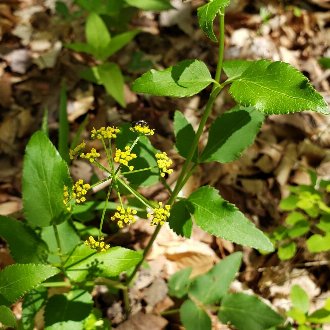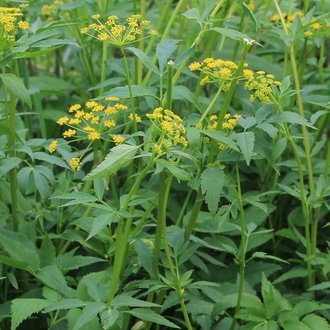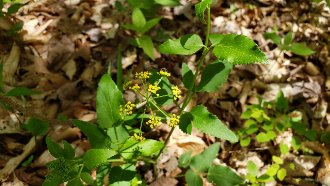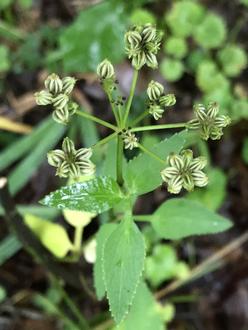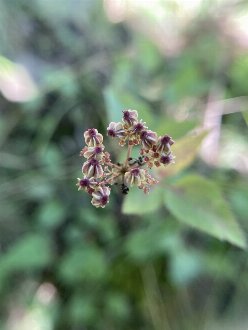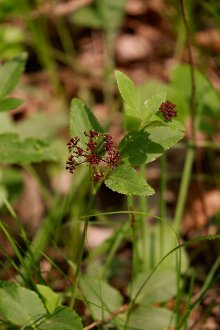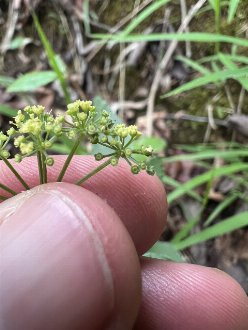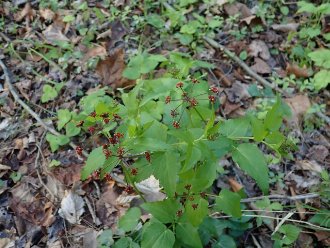Meadow Parsnip (Thaspium trifoliatum (L.) A. Gray)
Also known as purple meadow parsnip, purple meadow-parsnip, yellow meadow parsnip, yellow meadow-parsnip.
↑Summary
A carrot-family perennial found mostly in woodlands, native to the eastern US.
↑Range - Expand
| Legend | Color |
| Native | |
| Native or Not Present |
This tentative map is based on our own research. It may have limited data on Canada and/or Mexico, and there is some subjectivity in our assignment of plants as introduced vs. expanded. Read more in this blog post.
Although this plant occurs somewhere in each of these regions, it may only occur in a small part of some or all of them.
This species is also native to Canada, but we have yet to build this portion of its range map.
↑Similar Plants
↑Habitat
The meadow parsnip has a fairly broad range of habitat preferences, but its preferences change considerably by region.
In the south of its range, it is mostly found in rich mesic forests, often in small openings. In the north of its range it is more restricted to openings and edge habitats such as rocky upland woods, and ranges farther into sunny habitats, and also occurs in prairies, savannas, and disturbed, anthropogenic habitats including abandoned fields, roadsides, and railroads.
It is relatively indifferent to soil types and can occur on a wide range of soils from loam to clay-loam, and rocky soils. In the south of its range it also occurs on sandy soils, on moist sites. It tolerates a broad range of moisture conditions, typically from moist to slightly dry, most often in mesic conditions. In the south of its range, it becomes more restricted to shade and more likely on moist sites, whereas in the north it ranges into sunnier conditions but is more restricted to mesic to dry-mesic conditions.
↑Life Cycle
Meadow parsnip is a perennial. We could not find any more information on its typical lifespan, or whether or not its seeds persist in the seed bank.
↑Uses
This species is uncommonly grown in landscaping, but is easy to grow and has many of the same visual and horticultural attributes as golden alexanders (Zizia aurea), which is widely grown. Var. trifoliatum has a unique deep maroon or burgundy colored flower, which provides an interesting visual accent in gardens.
↑Links & External Resources
• Thaspium trifoliatum (purple meadowparsnip) | USDA PLANTS Database (About This Site)
• Thaspium trifoliatum | Go Botany (About This Site)
• Thaspium trifoliatum (Purple Meadow Parsnip) | Missouri Botanical Garden Plant Finder (About This Site)
• Thaspium trifoliatum | Biota of North America Project (BONAP) (About This Site)
• Thaspium trifoliatum (L.) A.Gray | Plants of the World Online (POWO) (About This Site)
• Thaspium trifoliatum | NatureServe Explorer (About This Site)
• Thaspium trifoliatum trifoliatum (Purple Meadow Parsnip) | Illinois Wildflowers (About This Site)
• Purple Meadow-parsnip | Maryland Biodiversity Project (About This Site)
• Thaspium trifoliatum (L.) Gray (Meadow Parsnip, Purple Meadow Parsnip) | Digital Atlas of the Virginia Flora (About This Site)



